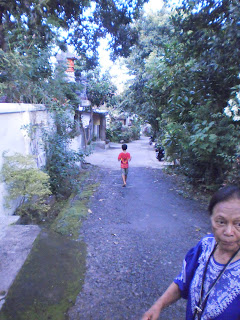It probably wasn’t on this first look, but maybe the next morning as I was taking the same walk, I passed the house directly next to ours, which is the first Orthodox church in Bali. Inside through the open doors and unshuttered windows I could just barely see the top of Ibu’s veiled head as she stood in prayer before the Holy Place. I think her daughter Titi, and maybe her granddaughter, were there as well. I did not join them, but instead I went over to the traditional Balinese family shrine in the corner of the compound, with its wrought iron gates and vertical altars decked with holy fabrics and offerings, entered, venerated the ikons, and prayed my morning prayers. I had learned, during my walk with Ibu my first morning in Bali what these shrines were, what they represented, for her people. I now understood why the shrines were essential, whether for Hindus or for Orthodox Christians.
That first morning, Ibu caught me looking around before Yudhie had emerged from our house, and she and I went for a short walk down Gang Satu, the lane off Jalan Kresna, the street where we live. It is a quiet neighborhood. A few children were already up and about. Little dogs played here and there. An occasional motorcycle drove by. Ibu showed me the trees and taught me what each one was. We encountered her neighbor standing in the gateway to his home, and he invited us in. He wanted to present me to his family shrine, and explain to me the meaning of each part of it. He is a Balinese Hindu, and so I learned the traditions of that faith with regard to each part of the shrine. The altar with the grey and white checkerboard fabric is always to the family guardian spirit, their naga, or dragon. Another altar was to their ancestors, and others were to gods specially venerated in that family.

The highest and most magnificent altar, fashioned as a very elaborate throne with its back facing exactly East, was to God Most-High. The neighbor didn’t speak English, but Ibu translated his Balinese. All family shrines in Bali have this throne, always facing in the same direction. It is the padmasana, and Sanghyang Widi Wasa, God Most-High, sits there ikonically. Speaking Balinese, I could still recognize him say the name Jesus as he told us, ‘that is where the Lord Jesus sits.’ He knew that Ibu his near neighbor is a Balinese Orthodox Christian and probably assumed I was too. Like all the people we met in Bali, and most that we met in our travels on the other islands, this neighbor tried his best to welcome us and treat us with respect, including acknowledging our religious faith. Yndonesia is a religious land, a land of the gods under God Most-High. You can’t escape Him by going there. The people won’t let you.
Ibu and I continued our walk and our conversation. A passing motorcyclist stopped in front of us suddenly, and a man in his early forties dismounted and greeted Ibu. He was her student when she was a teacher! That’s how connected people are here. Ibu is eighty-two years old! and still a man remembers her, though she lives in America ten months out of the year, and for the past twenty-five years. The government awarded her the property she and her family now occupy because of her contribution to the advancement of the country. Not only does the compound where we lived belong to her, but also the greenway between Gang Satu and (I think) Gang Dua, as well as at least one house on Gang Dua. That house is occupied by her son Moda and his wife and children. We stopped by their house on our morning walk, and I met the family, but Moda was still sleeping in, so he’s not in the picture.
When we returned from our walk, Yudhie was up and was about to take his bath. Ibu brought me into the dining area of the kitchen and we had breakfast, she and I, until Yudhie joined us. Such variety of food, always cooked, always starting with rice, even in the morning! Kopi manis was brought me that morning and every morning, sweet, very sweet Balinese coffee. Later, while we waited for everyone to get ready for our first day trip—to the mother temple of all Bali, Besakih—Yudhie and I sat together out in the balé, a kind of covered patio with a raised floor, and continued having teh manis, sweet tea (for Yudhie) and kopi manis (for me), along with some sweets. Members of the household who were leaving for work—Titi’s husband—or for school—her daughter—came over to say good morning and see you later, and then got on their motorcycles and drove off. Even in Bali, motorcycles rule.
Next… Face to face









Tidak ada komentar:
Posting Komentar